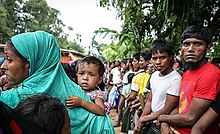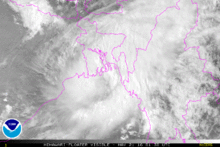
Politics of Bangladesh takes place in a framework of a parliamentary representative democratic republic, whereby the Prime Minister of Bangladesh is the head of government and of a multi-party system. Executive power is exercised by the government. Legislative power is vested in both the government and parliament. The Constitution of Bangladesh was written in 1972 and has undergone seventeen amendments.

The prime minister of Bangladesh, officially prime minister of the People's Republic of Bangladesh, is the chief executive of the government of Bangladesh. The prime minister and the cabinet are collectively accountable for their policies and actions to the Parliament, to their political party and ultimately to the electorate. The prime minister is ceremonially appointed by the president of Bangladesh.
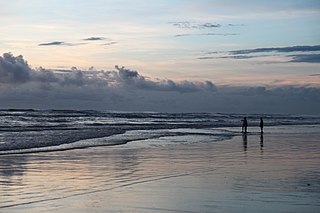
Cox's Bazar is a city, fishing port, tourism centre, and district headquarters in southeastern Bangladesh. Cox's Bazar Beach, one of the most popular tourist attractions in Bangladesh, is the longest uninterrupted naturally occurring sea beach in the world. Located 150 km (93 mi) south of the city of Chittagong, Cox's Bazar is also known by the name Panowa, which translates literally as "yellow flower." An old name was "Palongkee".

General elections were held in Bangladesh on 29 December 2008. The two main parties in the election were the Bangladesh Nationalist Party (BNP), led by Khaleda Zia, and the Bangladesh Awami League Party, led by Sheikh Hasina. The Bangladesh Awami League Party formed a fourteen-party Grand Alliance including Ershad's Jatiya Party, while the BNP formed a four-party alliance which included the Islamist party Jamaat-e-Islami. The election was originally scheduled for January 2007, but it was postponed by a military-controlled caretaker government for an extended period of time.
1978 (MCMLXXVIII) was a common year starting on Sunday of the Gregorian calendar, the 1978th year of the Common Era (CE) and Anno Domini (AD) designations, the 978th year of the 2nd millennium, the 78th year of the 20th century, and the 9th year of the 1970s decade.

General elections were held in Bangladesh on 5 January 2014, in accordance with the constitutional requirement that elections must take place within the 90-day period before the expiration of the term of the Jatiya Sangshad on 24 January 2014.
The 2012 Ramu violence refers to a series of attacks on Buddhist monasteries, shrines, and houses of Buddhist inhabitants in Ramu Upazila in Cox's Bazar District in Bangladesh by local mobs on the midnight past 29 September 2012. The mobs destroyed 24 Buddhist temples and monasteries and 75 houses in reaction to a tagging of an image depicting the desecration of a Quran on the timeline of a fake Facebook account under a Buddhist male name. The actual posting of the photo was not done by the Buddhist who was falsely slandered. The Buddhist was innocent of the accusation. The violence later spread to Ukhia Upazila in Cox's Bazar District and Patiya Upazila in Chittagong District where Buddhist monasteries and Hindu temples were targeted for attacks.

General elections were held in Bangladesh on 30 December 2018 to elect 300 directly-elected members of the Jatiya Sangsad. The result was another landslide victory for the Awami League-led Grand Alliance led by Sheikh Hasina. The elections were marred by violence, and were widely considered by opposition politicians and the international community to be rigged.
2016 (MMXVI) was a leap year starting on Friday of the Gregorian calendar, the 2016th year of the Common Era (CE) and Anno Domini (AD) designations, the 16th year of the 3rd millennium and the 21st century, and the 7th year of the 2010s decade.

Jahangir Kabir Nanak is a Bangladesh Awami League politician. He was a Minister of Textiles and Jute and a former Member of Parliament representing the Dhaka-13 constituency. Nanak is also a Presidium Member of the Awami League Central Committee. Previously, he served as the State Minister for Local Government, Rural Development and Co-operatives
2017 (MMXVII) was a common year starting on Sunday of the Gregorian calendar, the 2017th year of the Common Era (CE) and Anno Domini (AD) designations, the 17th year of the 3rd millennium and the 21st century, and the 8th year of the 2010s decade.
Bhasan Char, also known as Char Bhasani, is an island in Hatiya Upazila, Bangladesh. Until 2019 it was known as Thengar Char. It is located in the Bay of Bengal, about 6 kilometres (3.7 mi) from Sandwip island and 37 miles (60 km) from the mainland.

Severe Cyclonic Storm Mora was a moderate but deadly tropical cyclone that caused widespread devastation and severe flooding in Sri Lanka, Andaman and Nicobar Islands, Bangladesh, Myanmar and Northeast India in May 2017. The second named storm of the 2017 annual cyclone season, Mora developed from an area of low pressure over the southeastern Bay of Bengal on May 28. Mora reached peak strength with maximum sustained winds of 110 km/h (70 mph). The cyclone made landfall near Chittagong on the morning of May 30 and steadily weakened, dissipating early in the morning on May 31. Across its path, Mora dropped a large amount of rain, including 225mm of rainfall in Chittagong and northeast India. The storm is estimated to have caused damages nearing US$300 million.
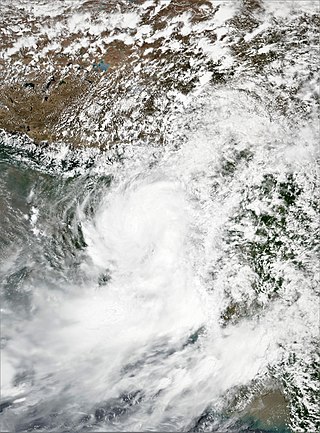
On 12 June 2017, heavy monsoon rain triggered a series of landslides and floods in Rangamati, Chittagong and Bandarban - three hilly districts of Bangladesh - and killed at least 152 people. The weather also caused power cuts and telecommunications disruptions, making it difficult for rescuers to reach affected communities. Reaz Ahmed, head of Bangladesh's Disaster Management Department, said the landslides were the worst in the country's history.

Kutupalong refugee camp is the world's largest refugee camp. It is located in Ukhia, Cox's Bazar, Bangladesh, and is inhabited mostly by Rohingya refugees who fled from ethnic and religious persecution in neighboring Myanmar. It is one of two government-run refugee camps in Cox's Bazar, the other being the Nayapara refugee camp.
Khorshed Ara Haque was a Bangladesh Jatiya Party politician and member of parliament. She was elected from a reserved seat for women.
The 2000s was a decade of the Gregorian calendar that began on 1 January 2000, and ended on 31 December 2009. For Bangladesh this decade was characterized by strife among the political parties over the caretaker government system for managing the national elections. Continued rapid urbanisation and globalization influenced the socio-economic and cultural activities of the country in this decade.
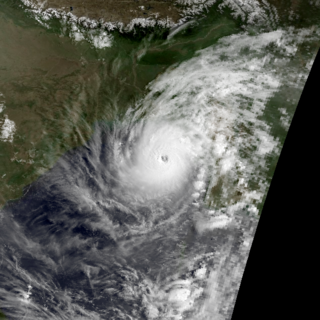
The 1994 Bangladesh cyclone was a powerful tropical cyclone in the Bay of Bengal. The cyclone closely followed the path, strength, and time of year of a deadly cyclone in 1991 that killed more than 138,000 people. The 1994 cyclone formed on April 29 as a depression, which organized and intensified significantly over the subsequent few days. On May 2, the cyclone attained winds of 215 km/h (135 mph), according to the India Meteorological Department (IMD). That day, the storm made landfall in southeastern Bangladesh, and rapidly weakened over land, before dissipating on May 3.
The following is a list of scheduled and expected events for the year 2024 in Bangladesh. 2024 (MMXXIV) was a leap year starting on Monday of the Gregorian calendar, the 2024th year of the Common Era (CE) and Anno Domini (AD) designations, the 24th year of the 3rd millennium and the 21st century, and the 5th year of the 2020s decade.

Sheikh Hasina's tenure as Prime Minister of Bangladesh began on 23 June 1996, when she assumed office after her party, the Awami League, won the general election, succeeding Khaleda Zia's Bangladesh Nationalist Party (BNP). Her first term lasted until 15 July 2001. She returned to office on 6 January 2009 following her party’s landslide victory in the 2008 general election and had further electoral wins in 2014, 2018 and 2024 general elections, though these elections was widely criticised for lacking transparency, with opposition parties boycotting those elections and international observers alleging vote manipulation and suppression.



